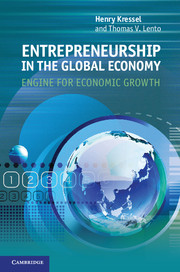Book contents
- Frontmatter
- Contents
- Figures
- Tables
- Acknowledgments
- Introduction
- 1 Government: Boss, financial partner, regulator – Entrepreneurs in mixed economies
- 2 Standing still is not an option: On promoting entrepreneurship and economic growth
- 3 Electronic innovation and the government: David Sarnoff creates the RCA empire
- 4 Global problem, golden opportunity: Ron Stanton profits from market disruption
- 5 Speeding voice and data traffic worldwide: Network microprocessors from RMI
- 6 A world leader emerges: SanDisk and flash memories
- 7 Implementing information technology across the globe
- 8 Three startups in China: Entrepreneurs in a controlled economy
- 9 Connecting the wireless networks of the world
- 10 Building an economy: Government planning vs. entrepreneurial innovation
- Select bibliography
- Index
6 - A world leader emerges: SanDisk and flash memories
Published online by Cambridge University Press: 05 August 2012
- Frontmatter
- Contents
- Figures
- Tables
- Acknowledgments
- Introduction
- 1 Government: Boss, financial partner, regulator – Entrepreneurs in mixed economies
- 2 Standing still is not an option: On promoting entrepreneurship and economic growth
- 3 Electronic innovation and the government: David Sarnoff creates the RCA empire
- 4 Global problem, golden opportunity: Ron Stanton profits from market disruption
- 5 Speeding voice and data traffic worldwide: Network microprocessors from RMI
- 6 A world leader emerges: SanDisk and flash memories
- 7 Implementing information technology across the globe
- 8 Three startups in China: Entrepreneurs in a controlled economy
- 9 Connecting the wireless networks of the world
- 10 Building an economy: Government planning vs. entrepreneurial innovation
- Select bibliography
- Index
Summary
Technologies emerge from the coming together of existing technologies into wholes that are greater than the sum of their parts.
Imagine having to re-program your smartphone, digital camera, music player, tablet computer, e-book reader, or similar device with phone numbers, photos, songs, or other crucial information every time you turned it on. Or think how much bigger its battery would be, and how often you would have to recharge it, if you decided to keep it powered up all the time so it would remember that data.
Fortunately, that’s one dilemma we don’t have to face. Our electronic devices keep all our information in memory, ready for use, even when we turn them off. They store the data in semiconductor chips called “flash memory,” either in the devices or on handy, removable memory cards and USB thumb drives. Their convenience and functionality are owing in large part to the flash memory innovations of Dr. Eli Harari.
Dr. Harari did not invent l ash memory. Credit for that goes to Toshiba , the giant Japanese electrical and electronics company, which developed the semiconductor chips in the mid-1980s. But he did i nd ways to improve their reliability. Even more important, he developed l ash memory systems. He developed and commercialized these systems through SanDisk , an amazingly successful startup, which he founded in 1988 in Silicon Valley.
- Type
- Chapter
- Information
- Entrepreneurship in the Global EconomyEngine for Economic Growth, pp. 149 - 171Publisher: Cambridge University PressPrint publication year: 2012



